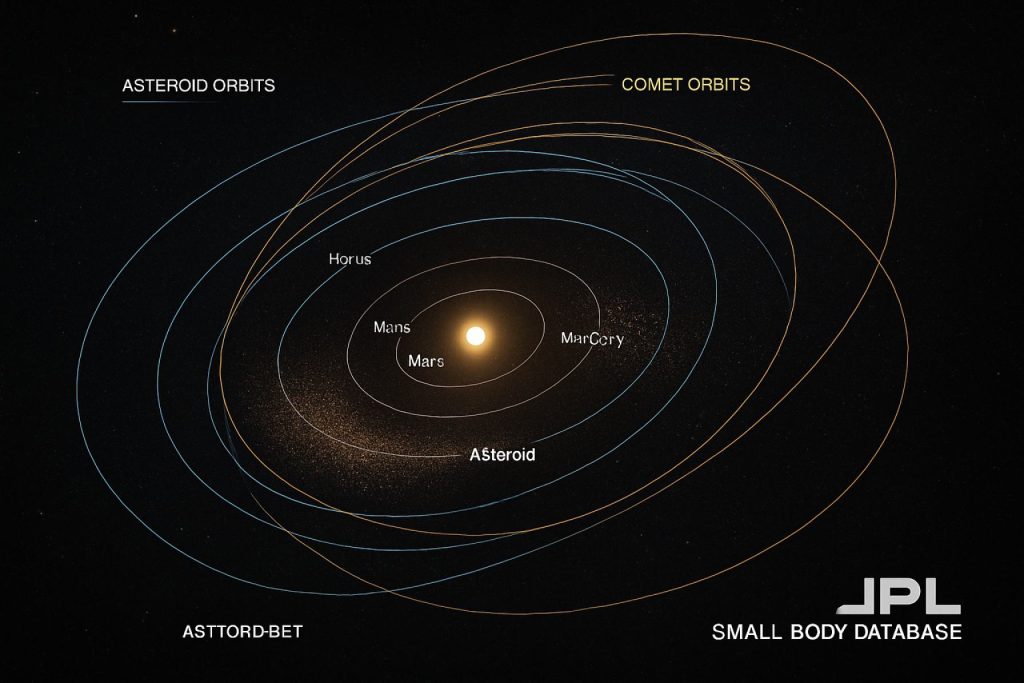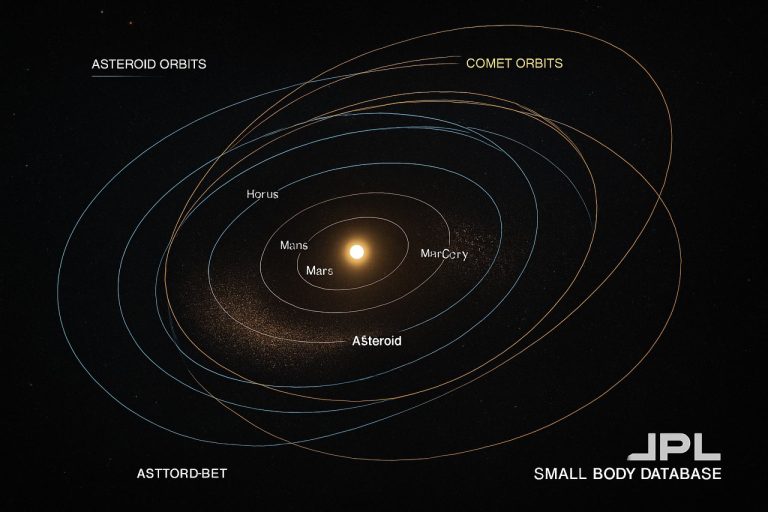
JPL Small-Body Database: The Ultimate Resource for Tracking Asteroids and Comets. Discover How NASA’s Data Powers Research, Risk Assessment, and the Future of Planetary Defense. (2025)
- Introduction to the JPL Small-Body Database
- Historical Development and NASA’s Role
- Database Architecture and Data Sources
- Key Features: Search, Visualization, and API Access
- Applications in Astronomy and Space Missions
- Planetary Defense: Impact Risk Assessment
- Integration with Other NASA Tools and Databases
- Recent Discoveries and Notable Small Bodies
- Public Engagement and Educational Initiatives
- Future Outlook: Expanding Data, AI Integration, and Projected 30% Growth in Public and Research Use by 2030
- Sources & References
Introduction to the JPL Small-Body Database
The JPL Small-Body Database is a comprehensive, publicly accessible resource that provides detailed information on small solar system bodies, including asteroids, comets, and certain planetary satellites. Maintained by the Jet Propulsion Laboratory (JPL), a federally funded research and development center managed by the California Institute of Technology for the National Aeronautics and Space Administration (NASA), the database serves as a critical tool for both the scientific community and the general public. It aggregates and curates data from a wide array of observational sources, including ground-based telescopes, space missions, and international collaborations, ensuring that the information remains current and authoritative.
The database includes orbital elements, physical parameters, discovery circumstances, and close-approach data for hundreds of thousands of objects. Its design allows users to search for specific bodies, retrieve up-to-date ephemerides, and access historical records of observations. The JPL Small-Body Database is integrated with other NASA resources, such as the Horizons system, which provides high-precision ephemeris computations, and the Center for Near-Earth Object Studies (CNEOS), which focuses on tracking and characterizing near-Earth objects (NEOs).
One of the key strengths of the JPL Small-Body Database is its commitment to accuracy and transparency. Data are continually updated as new observations are reported and as orbital solutions are refined. The database also provides uncertainty estimates and quality indicators, allowing researchers to assess the reliability of the information. This is particularly important for planetary defense initiatives, mission planning, and scientific studies of solar system evolution.
The JPL Small-Body Database is widely used by astronomers, planetary scientists, mission designers, educators, and amateur astronomers. Its open-access model supports international collaboration and public engagement, reflecting NASA’s broader commitment to open science and data sharing. As of 2025, the database remains a cornerstone of small-body research, supporting ongoing and future missions such as OSIRIS-REx, DART, and the upcoming NEO Surveyor, and contributing to our understanding of the dynamic and diverse population of small bodies in the solar system.
Historical Development and NASA’s Role
The JPL Small-Body Database (SBDB) is a cornerstone resource for the global planetary science community, providing comprehensive and up-to-date information on asteroids, comets, and other small bodies in the Solar System. Its historical development is closely tied to the evolution of planetary science and the increasing need for accurate, accessible data on minor celestial objects. The database is managed by the Jet Propulsion Laboratory (JPL), a federally funded research and development center operated by the California Institute of Technology for the National Aeronautics and Space Administration (NASA).
The origins of the SBDB trace back to the late 20th century, when the rapid discovery of new asteroids and comets outpaced traditional cataloging methods. Recognizing the need for a centralized, dynamic repository, JPL began developing digital tools to aggregate and disseminate orbital and physical data. The SBDB was formally established in the 1990s, leveraging JPL’s expertise in celestial mechanics, mission planning, and data systems. Its creation coincided with the rise of automated sky surveys and the growing importance of near-Earth object (NEO) tracking for planetary defense.
NASA’s role in the SBDB’s development has been pivotal. As the primary U.S. agency for space exploration and research, NASA has long prioritized the study of small bodies due to their scientific value and potential impact hazards. JPL, as NASA’s lead center for robotic planetary missions, was tasked with building and maintaining the SBDB. The database integrates data from NASA-funded surveys, international observatories, and mission results, ensuring a comprehensive and authoritative resource. Over the years, the SBDB has expanded to include not only orbital elements and discovery circumstances, but also physical parameters such as size, albedo, and spectral type.
The SBDB’s evolution reflects broader trends in planetary science and data management. It has adopted open-access principles, allowing researchers, mission planners, and the public to retrieve and analyze data freely. The database is continually updated as new discoveries are made and as existing objects are observed in greater detail. Its integration with other NASA resources, such as the Center for Near-Earth Object Studies (CNEOS) and the Planetary Data System (PDS), exemplifies NASA’s commitment to collaborative, data-driven science (Jet Propulsion Laboratory).
By 2025, the JPL Small-Body Database stands as a testament to NASA’s leadership in planetary science and its enduring commitment to public data stewardship. Its historical development underscores the importance of robust, accessible databases in advancing both scientific discovery and planetary defense.
Database Architecture and Data Sources
The JPL Small-Body Database (SBDB) is a comprehensive repository managed by the Jet Propulsion Laboratory (JPL), a division of the California Institute of Technology and a key center for robotic exploration of the solar system under the auspices of NASA. The SBDB is designed to provide detailed, up-to-date information on small solar system bodies, including asteroids, comets, and certain planetary satellites. Its architecture and data sources reflect the need for both scientific rigor and accessibility for a wide range of users, from researchers to mission planners.
At its core, the SBDB is built on a relational database architecture, which allows for efficient storage, retrieval, and cross-referencing of vast quantities of data. The database schema is structured to accommodate a variety of object types, each with associated orbital elements, physical parameters, discovery circumstances, and observational histories. The system is engineered for scalability, supporting regular updates as new discoveries are made and as existing data are refined through ongoing observations and analysis.
The primary data sources for the SBDB are the Minor Planet Center (MPC), which operates under the Center for Astrophysics | Harvard & Smithsonian, and the International Astronomical Union (IAU). The MPC is the globally recognized clearinghouse for positional measurements and orbits of minor planets, comets, and outer irregular natural satellites. It aggregates observations from a worldwide network of professional and amateur astronomers, providing the foundational astrometric and photometric data that feed into the SBDB.
In addition to MPC data, the SBDB incorporates results from JPL’s own orbit determination and prediction software, which utilizes advanced numerical integration techniques and up-to-date planetary ephemerides. This enables the database to offer high-precision orbital solutions, including uncertainty estimates and future close-approach predictions. Physical parameters such as size, albedo, and rotation period are sourced from a combination of ground-based telescopic surveys, space missions (e.g., NEOWISE, OSIRIS-REx), and peer-reviewed scientific literature.
The SBDB is designed for interoperability, providing data access through web interfaces, APIs, and downloadable tables. This facilitates integration with other NASA planetary data systems and supports a broad spectrum of scientific and operational applications, including mission design, planetary defense, and public outreach. The database’s architecture and data sourcing practices ensure that it remains a trusted, authoritative resource for the global planetary science community.
Key Features: Search, Visualization, and API Access
The JPL Small-Body Database, maintained by the National Aeronautics and Space Administration (NASA) through its Jet Propulsion Laboratory (JPL), is a comprehensive resource for information on asteroids, comets, and other small bodies in the Solar System. The database is widely used by researchers, mission planners, and educators for its robust set of features, which include advanced search capabilities, interactive visualization tools, and programmatic API access.
Search Functionality
The database offers a powerful search interface that allows users to query its extensive catalog of small bodies using a variety of parameters. Users can search by object designation, name, orbital elements, physical characteristics, or discovery circumstances. The search system supports both simple queries and complex, multi-parameter filtering, enabling users to quickly locate specific objects or generate lists based on custom criteria. This flexibility is essential for scientific research, mission planning, and educational purposes, as it allows for targeted data retrieval from a dataset containing hundreds of thousands of entries.
Visualization Tools
A key feature of the JPL Small-Body Database is its suite of visualization tools. These include interactive orbit diagrams that display the real-time orbits of selected objects within the Solar System, as well as 3D visualizations that help users understand the spatial relationships and trajectories of small bodies relative to planets and other celestial objects. The visualization tools are designed to be intuitive and accessible, supporting both expert analysis and public outreach. They are particularly valuable for illustrating orbital dynamics, close approaches, and potential impact scenarios.
API Access
To facilitate automated data retrieval and integration with external applications, the JPL Small-Body Database provides a well-documented Application Programming Interface (API). This API allows users to programmatically access up-to-date information on orbital elements, physical parameters, and discovery data for all cataloged objects. Researchers and developers can use the API to build custom tools, perform large-scale data analyses, or integrate small-body data into mission planning software. The API is maintained by Jet Propulsion Laboratory, a leading center for robotic exploration of the Solar System and a division of the California Institute of Technology.
Collectively, these features make the JPL Small-Body Database an indispensable tool for the planetary science community, supporting both fundamental research and practical applications in planetary defense and space exploration.
Applications in Astronomy and Space Missions
The JPL Small-Body Database is a cornerstone resource for the astronomical and space mission communities, providing comprehensive and up-to-date information on the orbits and physical properties of asteroids, comets, and other small bodies in the Solar System. Maintained by the Jet Propulsion Laboratory (JPL), a federally funded research and development center managed by the California Institute of Technology for the National Aeronautics and Space Administration (NASA), the database is widely recognized for its accuracy and accessibility.
In astronomy, the JPL Small-Body Database is indispensable for both professional and amateur astronomers. It enables users to retrieve precise orbital elements, ephemerides, and physical parameters for hundreds of thousands of known small bodies. This information is crucial for planning observations, tracking near-Earth objects (NEOs), and studying the dynamical evolution of the Solar System. The database’s integration with tools such as the Horizons system allows astronomers to generate custom ephemerides and simulate future positions of small bodies, supporting research on asteroid families, cometary activity, and impact risk assessment.
For space missions, the database serves as a foundational planning tool. Mission designers and navigators rely on its data to select targets, design trajectories, and ensure spacecraft safety. Notable missions such as NASA’s OSIRIS-REx, which visited the asteroid Bennu, and the upcoming Psyche mission, which will explore a metallic asteroid, have utilized the JPL Small-Body Database for mission planning and navigation. The database’s regularly updated orbital solutions, derived from worldwide observations, are essential for accurate targeting and rendezvous operations. Additionally, the database supports planetary defense initiatives by providing timely updates on potentially hazardous objects, enabling rapid response and mitigation planning.
Beyond direct mission support, the JPL Small-Body Database underpins a wide range of scientific investigations. Researchers use its data to study the distribution, composition, and collisional history of small bodies, shedding light on the early Solar System’s formation and evolution. The database also facilitates international collaboration, as its open-access model allows scientists and mission planners worldwide to share a common, authoritative reference for small-body data.
In summary, the JPL Small-Body Database is a vital asset for astronomy and space exploration, enabling precise observation, mission planning, and scientific discovery. Its ongoing development and maintenance by Jet Propulsion Laboratory ensure that it remains at the forefront of small-body research and planetary defense efforts.
Planetary Defense: Impact Risk Assessment
The JPL Small-Body Database is a cornerstone resource for planetary defense, providing comprehensive and up-to-date information on asteroids, comets, and other small bodies within our solar system. Maintained by the Jet Propulsion Laboratory (JPL), a federally funded research and development center managed by the National Aeronautics and Space Administration (NASA), the database serves as a critical tool for scientists, mission planners, and planetary defense specialists worldwide.
The database aggregates and curates orbital elements, physical parameters, and discovery circumstances for hundreds of thousands of small bodies. It is continuously updated with new observations from ground-based telescopes, space missions, and survey programs, ensuring that the latest data is available for risk assessment and research. The JPL Small-Body Database is particularly vital for tracking Near-Earth Objects (NEOs)—asteroids and comets whose orbits bring them close to Earth—and for evaluating their potential impact risk.
One of the primary functions of the database in planetary defense is to support impact risk assessment. By providing precise orbital data and uncertainty estimates, the database enables the calculation of close approaches and potential impact probabilities for NEOs. This information is used by NASA’s Planetary Defense Coordination Office (PDCO) and international partners to prioritize monitoring efforts and inform mitigation strategies. The database also interfaces with automated systems such as Sentry, which continuously scans for possible future Earth impact events and updates risk assessments as new data becomes available.
The JPL Small-Body Database is accessible to the public and the scientific community, offering search tools, visualization options, and downloadable datasets. Its open-access nature fosters international collaboration and transparency in planetary defense efforts. Researchers use the database to model asteroid trajectories, study population statistics, and plan spacecraft missions, while educators and the public benefit from its educational resources and outreach materials.
In 2025, the role of the JPL Small-Body Database remains central as the volume of discovered NEOs continues to grow, driven by advanced survey telescopes and space-based observatories. Its integration with global observation networks and automated risk assessment tools ensures that planetary defense strategies are informed by the most accurate and current data available, reinforcing Earth’s preparedness against potential asteroid impacts.
Integration with Other NASA Tools and Databases
The Jet Propulsion Laboratory (JPL) Small-Body Database (SBDB) is a cornerstone resource for the astronomical community, providing comprehensive data on asteroids, comets, and other small Solar System bodies. Its integration with other NASA tools and databases significantly enhances its utility, enabling researchers, mission planners, and educators to access, analyze, and cross-reference small-body data efficiently.
One of the primary integrations is with NASA’s Solar System Dynamics Group resources, particularly the Horizons system. Horizons offers highly accurate ephemerides for solar system objects, and the SBDB serves as a foundational data source for object identification, orbital elements, and physical parameters. This synergy allows users to seamlessly transition from static database queries in the SBDB to dynamic trajectory and position calculations in Horizons, supporting both scientific research and mission design.
The SBDB is also closely linked with the NASA Planetary Data System (PDS), which archives and distributes scientific data from NASA planetary missions. Cross-referencing between the SBDB and PDS enables users to locate observational and mission-derived datasets associated with specific small bodies, facilitating comprehensive studies that combine orbital, physical, and compositional information.
Another important integration is with the Center for Near-Earth Object Studies (CNEOS), which monitors and analyzes near-Earth objects (NEOs) for potential impact hazards. The SBDB provides the authoritative source for NEO designations, orbital parameters, and discovery circumstances, which CNEOS uses in its risk assessment and impact monitoring tools. This ensures consistency and reliability in the identification and tracking of potentially hazardous asteroids and comets.
Additionally, the SBDB supports interoperability with external astronomical databases and tools through standardized data formats and APIs. For example, it can be accessed programmatically for integration with visualization platforms, mission planning software, and educational applications. This open-access approach aligns with NASA’s commitment to data transparency and broad scientific collaboration.
In summary, the JPL Small-Body Database’s integration with other NASA tools and databases—such as Horizons, the Planetary Data System, and CNEOS—creates a robust ecosystem for small-body research. These connections streamline workflows, enhance data reliability, and empower a wide range of users to explore and understand the dynamic population of small bodies in our Solar System.
Recent Discoveries and Notable Small Bodies
The Jet Propulsion Laboratory (JPL) Small-Body Database is a critical resource for tracking and cataloging asteroids, comets, and other minor bodies within our solar system. Managed by JPL, a division of the California Institute of Technology and a leading center for robotic exploration of the solar system, the database is continuously updated with new discoveries and refined orbital data. In 2025, the database has played a pivotal role in documenting recent discoveries and highlighting notable small bodies that have attracted scientific and public interest.
One of the most significant recent additions to the JPL Small-Body Database is the detection of several near-Earth objects (NEOs) with close approaches predicted for the coming years. For example, the asteroid 2025 AB1, discovered in early 2025, was quickly cataloged and its orbit calculated, allowing for precise risk assessment and follow-up observations. The database’s integration with observation networks worldwide ensures that new objects are rapidly incorporated and made available to researchers and mission planners.
Comet activity has also been a focus in 2025, with the database recording the return of periodic comet 12P/Pons-Brooks, which exhibited an unusually bright outburst visible to ground-based telescopes. The JPL Small-Body Database provided up-to-date orbital elements and ephemerides, supporting both professional and amateur astronomers in tracking the comet’s progress across the sky. Such real-time updates are essential for coordinating observation campaigns and for public outreach efforts.
Another notable entry is the interstellar object 2I/Borisov, which, although discovered in 2019, continues to be studied extensively. The JPL Small-Body Database remains the authoritative source for its trajectory and physical parameters, supporting ongoing research into its composition and origin. The database’s ability to accommodate both solar system and interstellar visitors underscores its comprehensive scope.
In addition to new discoveries, the JPL Small-Body Database has been instrumental in supporting planetary defense initiatives. By providing detailed information on the orbits, sizes, and physical characteristics of potentially hazardous asteroids (PHAs), the database enables agencies such as NASA and international partners to assess impact risks and develop mitigation strategies.
Overall, the JPL Small-Body Database remains an indispensable tool for the astronomical community, offering authoritative, up-to-date information on the ever-growing population of small bodies in our solar system and beyond.
Public Engagement and Educational Initiatives
The Jet Propulsion Laboratory (JPL), a federally funded research and development center managed by the California Institute of Technology for the National Aeronautics and Space Administration (NASA), maintains the Small-Body Database (SBDB) as a cornerstone resource for both the scientific community and the public. Beyond its technical utility, the SBDB plays a significant role in public engagement and educational initiatives, fostering a broader understanding of our solar system’s small bodies—asteroids, comets, and other minor planets.
JPL’s commitment to public outreach is evident in the accessible design of the SBDB. The database provides user-friendly search tools, interactive visualizations, and up-to-date orbital data, making it approachable for educators, students, amateur astronomers, and the general public. Through the SBDB, users can explore detailed information about thousands of small bodies, including their discovery circumstances, orbital parameters, and physical characteristics. This transparency supports educational curricula and independent learning, allowing users to engage directly with real scientific data.
Educational initiatives often leverage the SBDB as a teaching tool. NASA’s education programs, in collaboration with JPL, have developed lesson plans and classroom activities that utilize SBDB data to teach concepts in astronomy, mathematics, and physics. For example, students can track the orbits of near-Earth objects, analyze asteroid composition, or simulate potential impact scenarios, all using authentic data from the database. These activities not only enhance STEM education but also inspire curiosity about planetary science and space exploration.
Public engagement is further amplified through JPL’s outreach events, such as public lectures, workshops, and citizen science projects. The SBDB is frequently highlighted in these forums, demonstrating how open data can empower individuals to participate in scientific discovery. Notably, the database supports citizen science initiatives like asteroid tracking campaigns, where amateur astronomers contribute observations that refine orbital calculations and improve planetary defense efforts.
JPL also collaborates with other NASA centers and international partners to ensure the SBDB remains a globally relevant resource. By providing multilingual support and integrating data from worldwide observatories, the database extends its educational impact beyond the United States, fostering a global community of learners and enthusiasts.
In summary, the JPL Small-Body Database exemplifies how open scientific resources can bridge the gap between research and public understanding. Through its educational initiatives and outreach efforts, JPL continues to inspire and inform, cultivating the next generation of scientists and space enthusiasts while promoting planetary awareness and stewardship.
Future Outlook: Expanding Data, AI Integration, and Projected 30% Growth in Public and Research Use by 2030
The future outlook for the JPL Small-Body Database is marked by significant expansion in both the breadth of its data and the sophistication of its analytical tools. As the volume of small-body discoveries accelerates—driven by next-generation sky surveys and space missions—the database is expected to integrate increasingly diverse datasets, including higher-resolution orbital parameters, physical characteristics, and spectral information. This expansion will be supported by ongoing collaborations with international observatories and space agencies, ensuring that the database remains a comprehensive and authoritative resource for the global scientific community.
A key trend shaping the database’s evolution is the integration of artificial intelligence (AI) and machine learning (ML) technologies. These tools are being developed to automate the classification of newly discovered objects, predict orbital changes, and identify potential Earth impactors with greater accuracy. AI-driven analytics will also facilitate the extraction of patterns from vast datasets, enabling researchers to uncover subtle correlations and trends that would be difficult to detect manually. The adoption of these technologies is expected to enhance the database’s utility for both professional astronomers and citizen scientists, democratizing access to advanced analytical capabilities.
Looking ahead to 2030, projections indicate that public and research use of the JPL Small-Body Database will grow by approximately 30%. This anticipated growth is attributed to several factors: the increasing accessibility of the database through user-friendly web interfaces and APIs, the rising interest in planetary defense and near-Earth object (NEO) monitoring, and the expanding role of small-body research in understanding solar system formation and evolution. Educational initiatives and outreach programs are also expected to drive greater engagement from students and amateur astronomers, further broadening the database’s user base.
The Jet Propulsion Laboratory (JPL), a division of the National Aeronautics and Space Administration (NASA), will continue to play a central role in maintaining and enhancing the database. JPL’s expertise in planetary science, mission operations, and data systems positions it as a leader in the stewardship of small-body data. As the database evolves, it is poised to remain an indispensable tool for scientific discovery, planetary defense, and public engagement well into the next decade.
Sources & References
- National Aeronautics and Space Administration
- Center for Astrophysics | Harvard & Smithsonian
- National Aeronautics and Space Administration (NASA)
- Solar System Dynamics Group
- Center for Near-Earth Object Studies (CNEOS)



